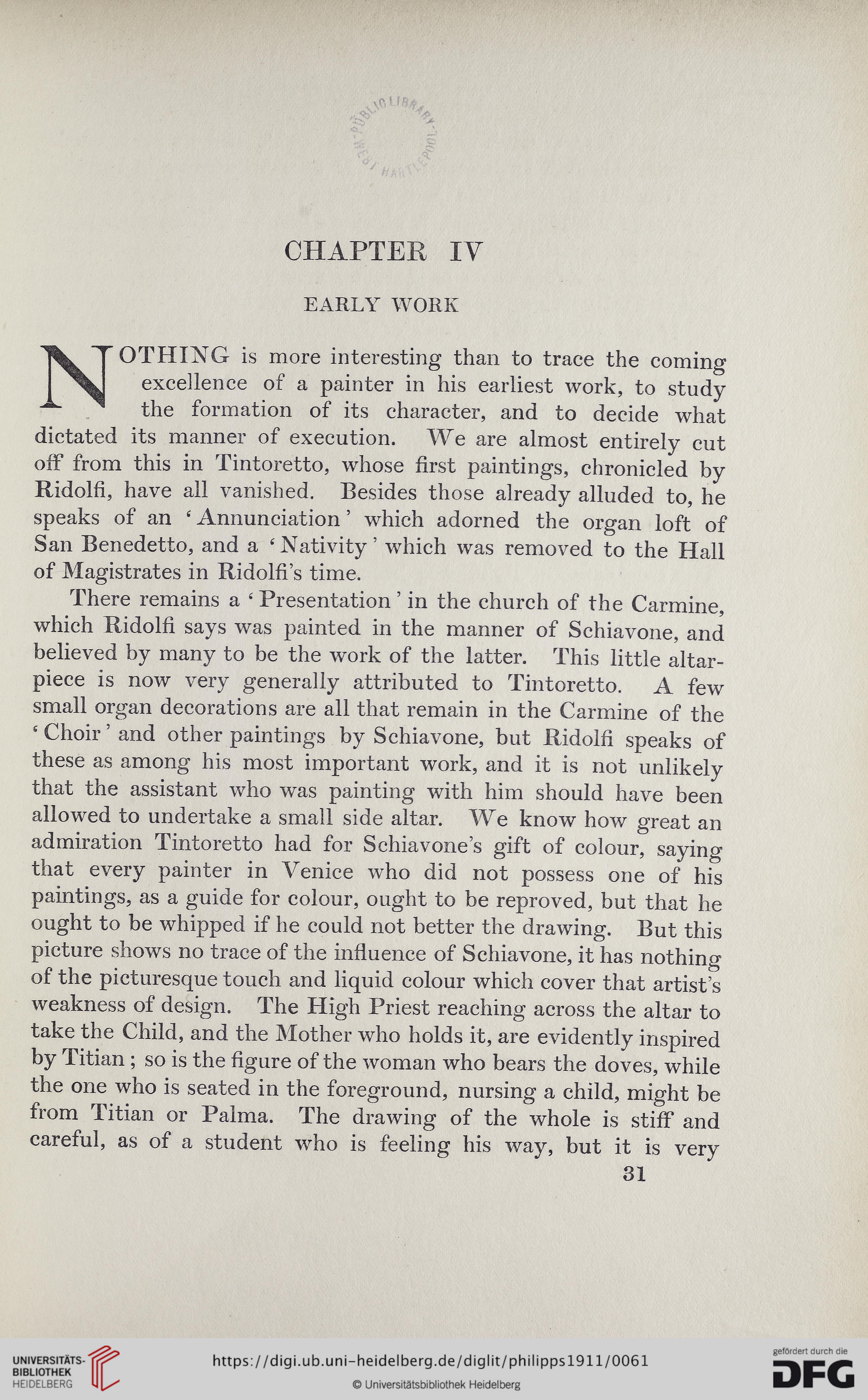CHAPTER IV
EARLY WORK
NR)THING is more interesting than to trace the coming
excellence of a painter in his earliest work, to study
the formation of its character, and to decide what
dictated its manner of execution. We are almost entirely cut
off from this in Tintoretto, whose first paintings, chronicled by
Ridolfi, have all vanished. Besides those already alluded to, he
speaks of an ‘ Annunciation ’ which adorned the organ loft of
San Benedetto, and a ‘Nativity’ which was removed to the Hall
of Magistrates in Ridolfi’s time.
There remains a ‘ Presentation ’ in the church of the Carmine,
which Ridolfi says was painted in the manner of Schiavone, and
believed by many to be the work of the latter. This little altar-
piece is now very generally attributed to Tintoretto. A few
small organ decorations are all that remain in the Carmine of the
‘Choir’and other paintings by Schiavone, but Ridolfi speaks of
these as among his most important work, and it is not unlikely
that the assistant who was painting with him should have been
allowed to undertake a small side altar. We know how great an
admiration Tintoretto had for Schiavone’s gift of colour, saying
that every painter in Venice who did not possess one of his
paintings, as a guide for colour, ought to be reproved, but that he
ought to be whipped if he could not better the drawing. But this
picture shows no trace of the influence of Schiavone, it has nothing
of the picturesque touch and liquid colour which cover that artist’s
weakness of design. The High Priest reaching across the altar to
take the Child, and the Mother who holds it, are evidently inspired
by Titian ; so is the figure of the woman who bears the doves, while
the one who is seated in the foreground, nursing a child, might be
from Titian or Palma. The drawing of the whole is stiff and
careful, as of a student who is feeling his way, but it is very
31
EARLY WORK
NR)THING is more interesting than to trace the coming
excellence of a painter in his earliest work, to study
the formation of its character, and to decide what
dictated its manner of execution. We are almost entirely cut
off from this in Tintoretto, whose first paintings, chronicled by
Ridolfi, have all vanished. Besides those already alluded to, he
speaks of an ‘ Annunciation ’ which adorned the organ loft of
San Benedetto, and a ‘Nativity’ which was removed to the Hall
of Magistrates in Ridolfi’s time.
There remains a ‘ Presentation ’ in the church of the Carmine,
which Ridolfi says was painted in the manner of Schiavone, and
believed by many to be the work of the latter. This little altar-
piece is now very generally attributed to Tintoretto. A few
small organ decorations are all that remain in the Carmine of the
‘Choir’and other paintings by Schiavone, but Ridolfi speaks of
these as among his most important work, and it is not unlikely
that the assistant who was painting with him should have been
allowed to undertake a small side altar. We know how great an
admiration Tintoretto had for Schiavone’s gift of colour, saying
that every painter in Venice who did not possess one of his
paintings, as a guide for colour, ought to be reproved, but that he
ought to be whipped if he could not better the drawing. But this
picture shows no trace of the influence of Schiavone, it has nothing
of the picturesque touch and liquid colour which cover that artist’s
weakness of design. The High Priest reaching across the altar to
take the Child, and the Mother who holds it, are evidently inspired
by Titian ; so is the figure of the woman who bears the doves, while
the one who is seated in the foreground, nursing a child, might be
from Titian or Palma. The drawing of the whole is stiff and
careful, as of a student who is feeling his way, but it is very
31




